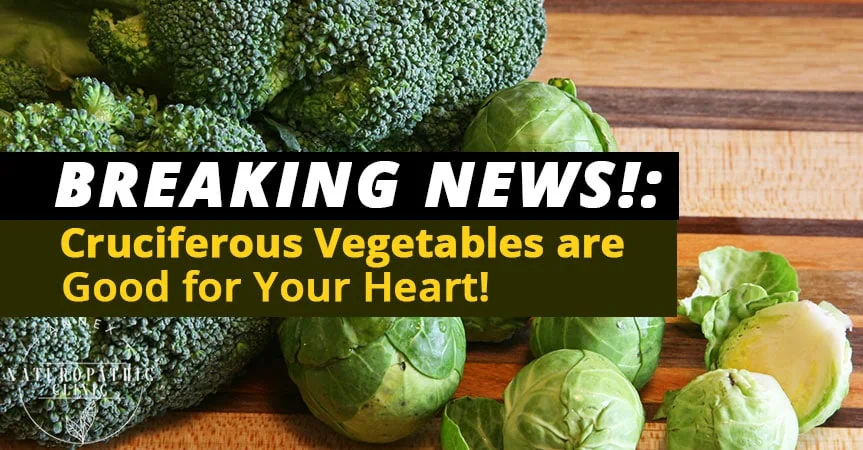I always love when a large journal publishes an article that outlines the benefits of recommendations Naturopathic Doctors have been suggesting for years!
Though we don’t really need a journal article telling us that green vegetables are good for you, the scientific validation definitely doesn’t hurt.
A new study published by the Journal of the American Heart Association found that eating higher amounts cruciferous vegetables, such as broccoli, cauliflower, brussel sprouts, and cabbage, is associated with lower risk of atherosclerosis (cardiovascular disease) older adult women.
Women who consume an overall vegetable intake of more than 3 servings daily had healthier arteries compared to women who ate 2 servings or less.
That’s pretty logical, right?
Interestingly enough, the study went on to find that women who consumed higher amounts of cruciferous vegetables had even healthier arteries compared to women who ate the same amount of overall vegetables, but consumed less cruciferous vegetables in their daily diet.
The Amazing Features of Cruciferous Vegetables
Brassica family (Cruciferous) vegetables are some of the most nutrient dense vegetables we can consume.
One of the best features is that most of our cruciferous vegetables are locally grown and can be EASILY grown in your own yard.
They also have a long shelf life, and can withstand and grow in cooler climates, making them easy to consume all year round.
I have kale plants that produced leaves well in to December outdoors before I had to bring them in from the cold/snow – and they kept producing in our back sunroom despite the below zero temperatures.
Many Health Benefits
Brassica vegetables improves cardiovascular health by adding a significant source of bioactive nutrients to optimize the body’s natural physiological processes, mainly through the liver.
Brassica vegetables provide the body with antioxidant nutrients such as vitamin C, E and carotenoids.
They are a rich source of other strong antioxidant compounds such as anthocyanidins, flavonoids and other phenolic compounds.
The high amounts of organosulfur and nitrogen-rich compounds unique to Brassica family vegetables are also beneficial to the cardiovascular system.
They are a rich source of fibre which binds to unwanted heart-unfriendly fats (ie too much saturated and transfats), and fat-souble toxins, preventing their absorption in to the bloodstream.
Together, these nutrients help keep the blood from becoming too thick with inflammation and cholesterol (ie Brassica vegetables can be mild blood thinners) and protect the blood vessels from being damaged by inflammation.
Consuming nutrient-dense Brassica family vegetable also decreases risk of cancer, inhibit the development of malignant cells, and reduces the spread of cancerous cells
Cruciferous vegetables play a beneficial role in optimizing liver function, which is considered the reason why they are protective against cancer.
These vegetables contain liver-supporting antioxidant enzymes (such as superoxide dismutase, and catalase), and detoxification-inducing nutrients (such as glucosinolates) which help the liver function optimally.
Glucosinolates in Brassica vegetables improve phase 1 and phase 2 detoxification by inducing gene expression of liver enzymes required for detoxification of environmental toxins, activating/deactivating and eliminating drugs and phytochemicals (from food and supplements), as well as regulating hormone metabolism (such as estrogen).
As complex as all of this may sound, the point is that Brassica vegetables help the body function optimally through many different mechanisms and therefore are an excellent addition to your diet.
Common Brassica (Cruciferous) Vegetables
– Broccoli
– Cabbage
– Cauliflower
– Kale
– Brussel sprouts
– Rutabaga
– Kohlrabi
– Rapini
– Mustard greens
– Collard Greens
– Daikon
– Watercress
– Arugala
– Horseradish
– Wasabi
Recommended Servings
I recommend eating 7 servings of vegetables daily, with >3 servings being Cruciferous vegetables.
Cruciferous vegetables can be a bit hard on digestion when eaten raw, but you don’t want to overcook them because they will become void of their heart and liver-friendly nutrients.
The compromise is to lightly steam or stir-fry the vegetables so they are still a bit crunchy, but soft and broken down enough so that your digestive system can handle it.
Another way to avoid digestive disturbances is to CHEW YOUR FOOD THROUGHLY – chewing throughly tremendously helps break down long fibre chains that your stomach acid, and pancreatic enzymes alone cannot to break down efficiently.
Cooking Suggestions
Steam or stir fry the greens until they look brighter than when raw – once they brighten up, immediately remove them from the heat.
They should be softer but still have a crunch!
References
Lauren C. Blekkenhorst et. al Cruciferous and Total Vegetable Intakes Are Inversely Associated With Subclinical Atherosclerosis in Older Adult Women JAHA. 2018; 7(8):e008391
Kapusta-Duch J. et. al, The beneficial effects of Brassica vegetables on human health.Rocz Panstw Zakl Hig. 2012;63(4):389-95.
Lampe JW, Peterson SBrassica, biotransformation and cancer risk: genetic polymorphisms alter the preventive effects of cruciferous vegetables.J Nutr. 2002 Oct;132(10):2991-4.



